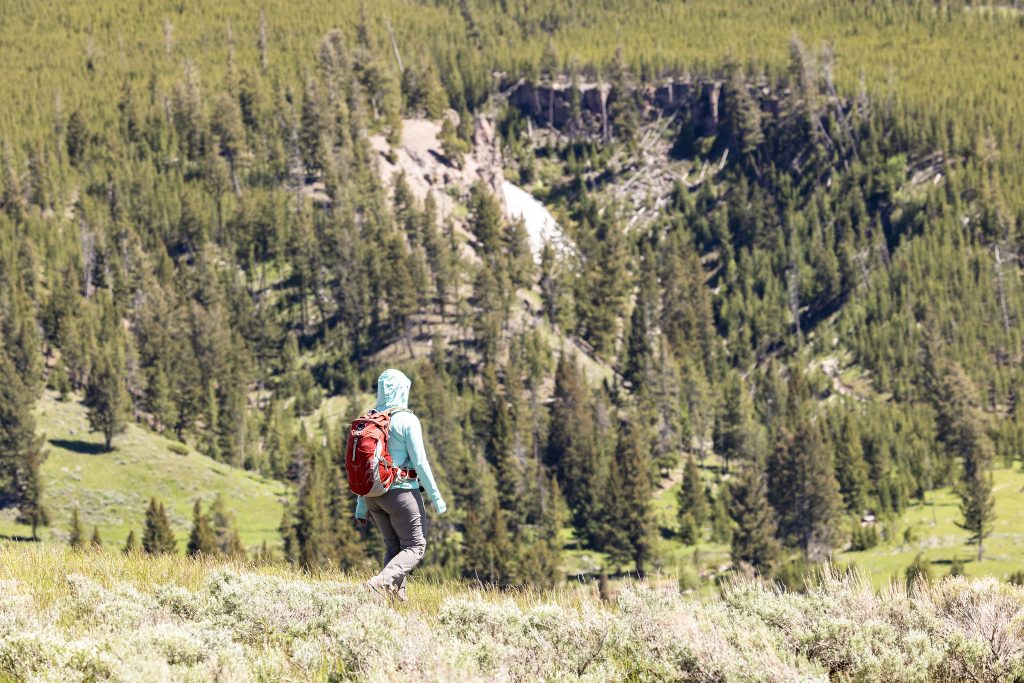6 Types of Wildlife to Look for While Driving From Cody to Yellowstone
Written by Nick on March 11, 2023
See Stunning Wildlife Between Cody and Yellowstone’s East Entrance
Dubbed by President Thodore Roosevelt as the most beautiful 50 miles in the United States, the drive between the city of Cody and the East Entrance to Yellowstone National Park is a superb opportunity to see a variety of wildlife.
The 52-mile drive along the North Fork of the Shoshone River takes you past Buffalo Bill Reservoir and through the Shoshone National Forest, which covers just shy of 2.5 million acres in total.
Established by President Benjamin Harrison in 1891, the Shoshone National Forest is home to some 335 native species of wildlife, so you’ll want to keep your camera handy.
Here’s a guide to six types of wildlife visitors will want to look for on their drive from Cody to Yellowstone National Park.
Grizzly and Black Bears
While both species call Yellowstone National Park home, grizzly and black bears can be found in the Shoshone National Forest, as well. Although visitors should treat both species with extreme caution, there are some notable differences between grizzly bears and black bears.
In 2019, it was estimated that some 728 grizzly bears live in the greater Yellowstone region, but the vast majority of these live outside the park boundaries.
The grizzly is typically larger than the black bear and, although all bears are potentially dangerous, the grizzly is far more aggressive. Grizzly bears can be identified by the large muscle mass above their shoulders and concave facial profile.
On the other hand, black bears are far more common in the Yellowstone area. Despite their name, only about half of black bears are actually black in color — the rest are brown, cinnamon, or blond.
Although they’re more reserved than grizzlies, black bears are powerful animals. A confrontation with a grizzly bear may prove fatal, so always maintain a 100-yard distance from bears and never approach a bear (or any wildlife) to take a photo.
Do yourself a favor and review these helpful tips on bear safety from the National Park Service before you visit.
Bighorn Sheep
Only a few hundred bighorn sheep called Yellowstone National Park home when the most recent survey was conducted, but they’re commonly seen outside the park, especially on either side of the canyon between the East Entrance and Cody.
In fact, there are more bighorn sheep in the Shoshone National Forest than any other national forest in the United States.
These animals are known for their distinctive horns. For rams, the size of their horns plays a part in determining their dominance within the herd.
Lambs are born in May or June, so the summer tourist season is a great time to see young Bighorn Sheep as you drive between Cody and Yellowstone.
Elk
Although European settlers gave these animals the name by which we know them today, the Shawnee word for elk is “wapiti.”
So, you won’t be surprised to learn that you’re seeing the Wapiti Ranger District of the Shoshone National Forest as you drive from Cody to Yellowstone. You’ll also pass through the community of Wapiti after you pass Buffalo Bill Reservoir.
Bull elk (males) tend to average 700 pounds apiece, while the cows (females) typically weigh 500 pounds each. Their mating season begins in early fall, and calves are born in May and June.
Like other ungulates, elk are popular among visitors due in part to their massive antlers. Antler growth begins in the spring, after the bulls shed their antlers from the previous year. Shedding usually occurs in March and April.
Look to the mountainsides on either side of the river if you want to catch a glimpse of these majestic mammals. The area around the Wapiti Ranger District office is also a place you’ll want to keep your eyes peeled.
Moose
Officials estimate that fewer than 200 moose live inside Yellowstone National Park. The population decline is attributed to the loss of old growth forests including wildfires, predators, and hunting outside the park.
Meadows and marshy areas are prime places to see moose, but you can also find them along rivers. Since you’ve got miles and miles of river alongside you as you drive toward the East Entrance from Cody, your drive to Yellowstone is a great opportunity to look for moose.
If you thought elk were big, you won’t believe the size of the average moose. Adult bulls usually weigh around 1,000 pounds, and cows weigh up to 900 pounds. At the shoulder, moose can stand up to 9.5 feet tall.
Moose don’t travel in herds like elk or mule deer. You’ll usually see them alone or in small groups. You may be lucky enough to spot a cow and calf together along the North Fork of the Shoshone River.
Bison
The world-famous Yellowstone bison is North America’s largest land mammal, with males weighing up to 2,000 pounds. But don’t let their huge bodies and spindly-looking legs fool you.
Too many Yellowstone visitors have made the mistake of thinking of bison as docile animals akin to livestock. Some have even tried to pet or ride bison, and they’ve paid the price. If these unwise visitors are lucky enough to avoid being gored by the bison, they’re issued a fine by the park service.
Bison are surprisingly quick and astonishingly powerful. Always observe them from a safe distance of at least 25 yards and never antagonize them.
It’s not uncommon for bison to travel east or west along the river between Cody and Yellowstone. Sometimes you’ll even find them walking along the edge of the highway.
Yellow-bellied Marmot
Often found in grassy or rocky areas — which you’ll find plenty of as you drive to Yellowstone — these marmots hibernate for up to eight months each year.
Yellow-bellied Marmots are one of the largest rodent species in Yellowstone. They can weigh anywhere from 3.5 to 11 pounds and are usually about two feet long.
The first settlers called them “whistle pigs” due to the sounds they make.
Yellow-bellied Marmots are active most of the day. Although they’re nowhere near the size of a grizzly bear or bison, marmots can still be aggressive and territorial.
Hope It Goes Without Saying…
It feels kind of silly to have to spell this out for folks, but please, whatever you do, never feed the wildlife you may encounter on your Yellowstone adventure.
When you offer food, you encourage wildlife to view humans and human dwellings as a food source. This can lead to human-wildlife conflicts that are dangerous and detrimental to everyone involved, especially the animals.
Tragically, wildlife managers occasionally must euthanize animals that have been taught to approach people or communities in search of food.
Also keep in mind that wildlife is just that: wild. They aren’t trained, supervised, or controlled by anyone. That means it’s your responsibility to keep yourself and the rest of your group safe as you take in the stunning flora and fauna that populate Yellowstone National Park and the Shoshone National Forest.
Never go within 100 yards of a bear or wolf. For all other wildlife, like elk and bison, always maintain a safe viewing distance of at least 25 yards.
If you’re making your first visit to Yellowstone, remember that every year, we see visitors do some pretty senseless things. Don’t be that person. Use common sense, follow posted instructions, and if you have a question about whether something is appropriate, please ask before you act.
Check out our helpful guide to enjoying Yellowstone National Park and the surrounding area — our home — responsibly. Thank you, and enjoy your journey!

